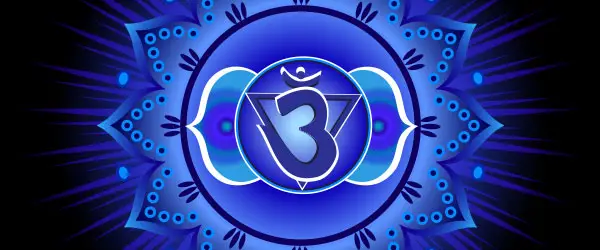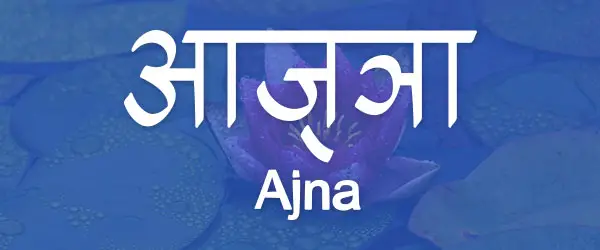
You may have seen the third eye chakra symbol and recognized the richness of meaning contained within it. This article will explore in detail all of the parts of the third eye chakra symbol and what they represent.
The third eye chakra is symbolized by a beautiful blend of Sanskrit writing, sacred geometry, and lotus flowers, and can be traced back millenniums. In the center is an Om symbol inside of an inverted triangle, contained within a circle. Outside of the circle are two lotus flowers. The third eye chakra symbol is indigo color.
Taken as a whole this symbol represents the third eye, but each element within it contains vast amounts of symbolism and meaning.
Symbols Within the Third Eye Chakra Symbol
Om
The Om symbolizes the sound or vibration made the moment all creation came into existence. It is the most sacred symbol in Hinduism. The Om represents Brahman, the highest universal principle in Hinduism, and the ultimate reality. Brahman is the cause of all that exists. The Om is written in Sanskrit, and each visual element represents different states of consciousness.
Unconscious state: The top curl of the ‘3’ shape denotes deep dreamless sleep and absence of desire.
Waking state: The large curve at the base of the ‘3’ represents conscious experience through the five senses.
Dreaming state: The middle curve between the unconscious and waking states denotes where dreams are experienced.
Maya state: The semi circle at the top represents the illusion through which we must transcend to obtain higher states of consciousness.
Absolute state: the dot at the top is the highest realm of consciousness and the ultimate state of spiritual bliss.
The Om is also a mantra, a slow vibrational sound, often used in yoga. Since the Om is the sound of creation, by chanting it we align ourselves in greater resonance with the universe.
Origins of the Om symbol
The Om is first mentioned in the Vedas, which were originally written in Sanskrit, and are the oldest scriptures of Hinduism. Specifically, the Om first appears in the Upanishads, an assortment of sacred texts in the Vedas that deal with Hindu concepts like karma, brahman, and atman. The Om is also widely seen in the Aranyaka and the Brahmana of the Vedic texts. The Om can be found in Buddhism and Jainism, a nontheistic religion founded in India in the 6th century BC.
The Om symbol appears throughout the history of Asia, and can be found on ancient coins. In Sri Lanka, coins from the first to fourth centuries were embossed with the Om symbol. In Thailand, the Om is seen on flags and emblems, such as the Thong Chom Klao, or official flag, of King Rama IV (1851-1868). The Om is seen in the official seal of Cambodia.
Inverted triangle
The inverted triangle in the third eye chakra symbol represents channeling of knowledge to the point of the triangle, or divine universal wisdom flowing down to the individual. When viewed in the upward direction, it also represents the expansion of knowledge of the seeker.
Circle
The circle is without beginning or end, and has no corners or sides. It is often seen as a protective symbol as standing within it shields from outside influences or dangers. The circle represents:
- Protection
- Wholeness
- Unity
- Totality
- The Infinite
- Eternity
- Timelessness
Two Lotus Pedals
The lotus is a beautiful flower that grows in a large region between India, China, and Iran and dates back 15 million years. It is seen most often in wetlands and grows in mud. This process of growing in mud before eventually rising above the water and becoming a beautiful flower is viewed in eastern philosophy as a metaphor for the human experience. Buddhists believe that we must be born thousands of times and experience great pain and suffering until we eventually transcend and experience nirvana, or pure spiritual bliss and enlightenment.
The lotus flower is widely used as a religious symbol in Hinduism and Buddhism and represents:
- Purity
- Beauty
- Fertility
- Eternity
- Enlightenment
- Rebirth
The two lotus flowers in the third eye chakra symbol imply the number 2, which in numerology is a feminine force. It is cooperative and seeks to bring peace and balance. The number is sensitive and intuitive.
The Third Eye Chakra’s Color is Indigo

Indigo combines the deep blue of devotion with a trace of the intense energy of the color red. The name Indigo is a Greek term meaning “from India.” Before modern dyes the color blue came from a plant called Indigofera, which grows in India, Africa, and Asia. The color indigo represents:
- Wisdom
- Faith
- Mystery
- Loyalty
The Sanskrit Name for the Third Eye Chakra is Ajna
The word Ajna means “perceive” or “beyond wisdom”. Sanskrit is a language believed to have been widely used in ancient India and can be traced to the 2nd millennium BC. Many great literary works from India were written in Sanskrit and Hindu and Buddhist chants and hymns are in this language. You can read more about the origins and history of the Sanskrit word Ajna here.
Recommended Reading
If you’d like to continue researching the third eye as well as the other chakras and energy systems, you can see which books I recommend on the subject by clicking here.







